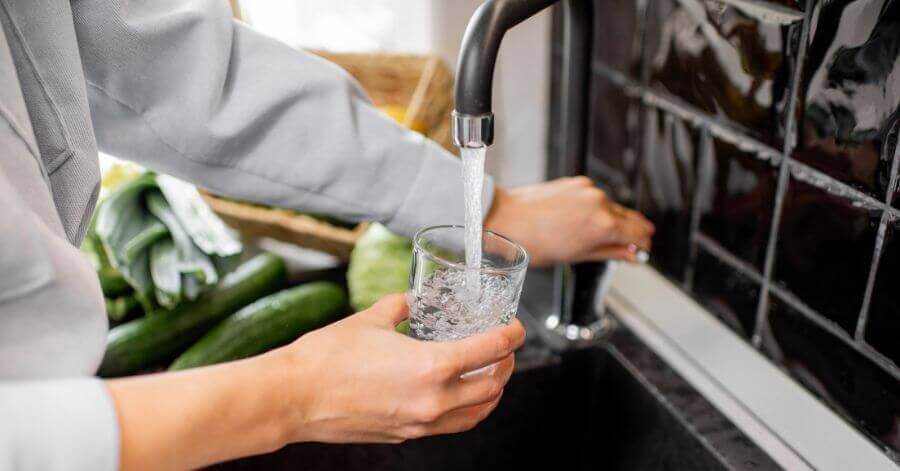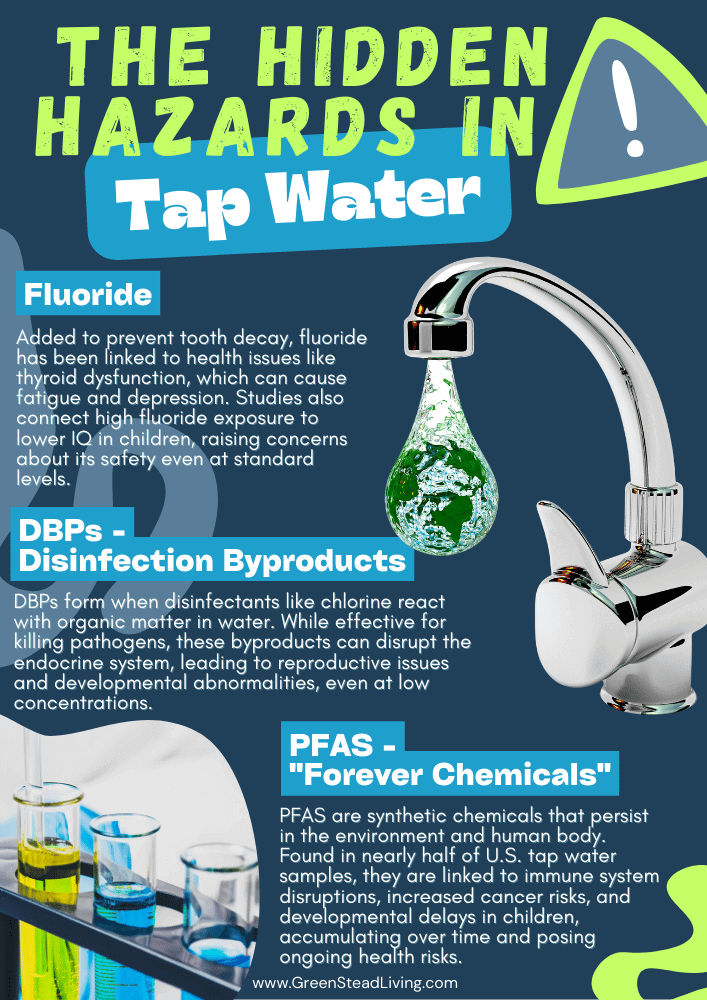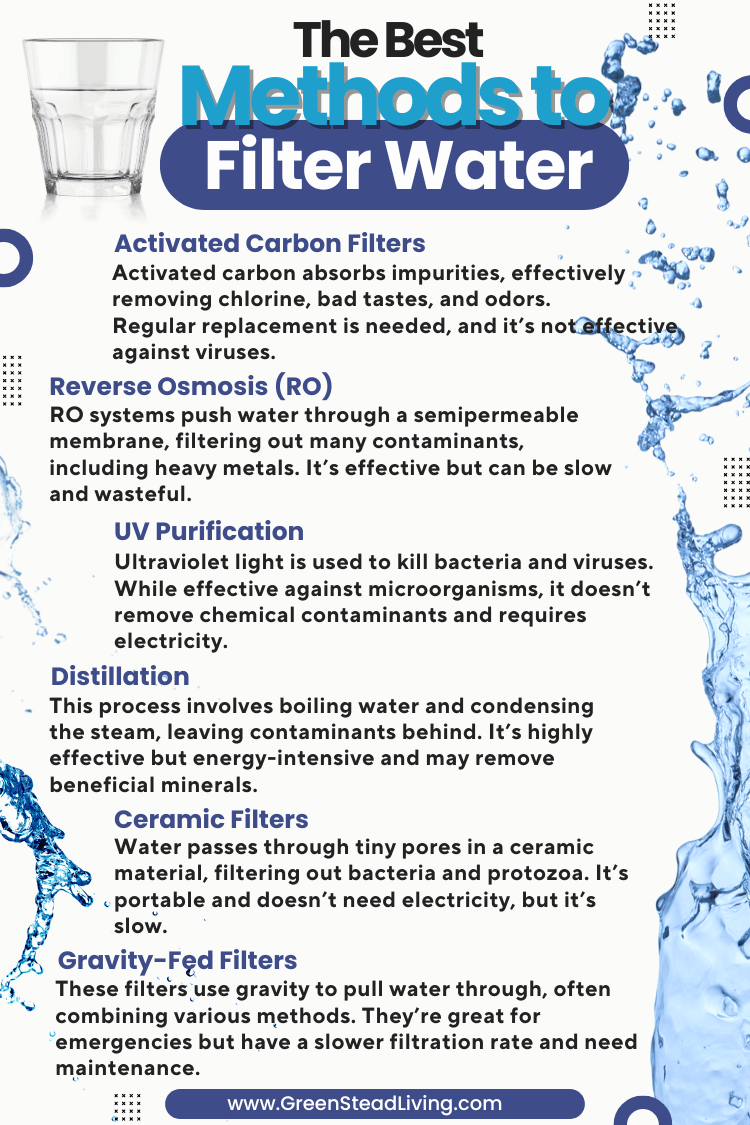
The Benefits Of Beef Tallow
The benefits of beef tallow include deep hydration, rich nutrients, and a natural alternative to synthetic moisturizers for healthy skin and cooking.

Have you ever stopped to consider what’s really in the water flowing from your tap? For many of us, tap water is a simple convenience—an everyday staple we trust without much thought. But with growing concerns over contaminants like disinfection byproducts, microplastics, and even “forever chemicals,” it’s time to rethink how safe our tap water truly is.
The quality of tap water varies dramatically depending on where it comes from, and even the most advanced water treatment technologies can’t eliminate the risks associated with certain pollutants. In fact, some of the chemicals used to make our water “safe” could be contributing to a host of health issues, from hormonal disruptions to developmental problems in children.
In this article, we’ll dive deep into the science behind tap water safety, exploring everything from the effectiveness of water treatment processes to the potential dangers lurking in your glass. Whether you’ve always trusted your tap or have considered switching to bottled water, what you’ll learn might just change the way you think about the water you drink every day.
Like how the quality of wine depends on the quality of its source grapes, the quality of tap water is heavily influenced by the natural water sources it comes from, such as rivers, lakes, or groundwater. While sophisticated water treatment technologies can reduce many contaminants, it is still largely dependent on the initial water source, varying significantly in terms of mineral content, pollution levels, and microbial activity.
Groundwater in agricultural regions, for example, might have higher levels of nitrates due to fertilizer runoff, whereas water sourced from urban areas may have higher levels of microplastics and trace pharmaceuticals.
Then we have the effectiveness of the treatment facilities, which varies widely. Europe boasts the top ten cleanest sources of tap water; the United Kingdom, Netherlands, and Greece take the top 3 spots, whereas the African countries Niger, Nigeria, and Togo provide the worst. The US and Canada lag behind their European peers at 90%. You can check your country’s water quality here.

Water treatment primarily revolves around using disinfectants like chlorine, chloramines, and ozone, which, although good at removing contaminants such as a broad range of pathogens, including bacteria, viruses, and protozoa, introduce disinfection byproducts (DBPs) once they have been chemically activated.
The problem is that these disinfectant byproducts have been shown through extensive studies to cause harm to human health, even in low quantities. While most professional bodies state that while DBPs pose potential health risks, the risk of not disinfecting water is far greater, an increasing body of research is showing that the risks from DBPs are perhaps greater than initially thought.
DBPs such as Trihalomethanes (THMs), Haloacetic Acids (HAAs), Bromate, Chlorite, and Chlorate are known to have carcinogenic potential and reproductive and developmental effects.
For some time, concerns have been raised about a potential link between water contaminants and reproductive health in both men and women. Fortunately, a comprehensive review conducted in 2020 examined water from various sources worldwide, with a particular focus on the levels of DBPs present in the sampled water.
The review underscored that DBPs have the potential to disrupt the endocrine system, which can lead to a range of adverse health effects, including reproductive, developmental, and metabolic issues. Specifically, DBPs were found to interfere with ovarian function, spermatogenesis (the production and development of sperm cells), and fertility outcomes, even at the low concentrations typically found in drinking water.
The study also highlighted the negative impact of these chemicals on reproductive health, linking them to reduced fertility, developmental abnormalities, and hormonal disruptions. For example, disinfection byproducts have been associated with developmental toxicity and pregnancy loss, fluorinated compounds with reduced sperm viability and endocrine disruption, and bisphenol A (BPA) exposure with diminished sperm quality and ovarian function.
If you’re concerned about the specific levels of DBPs and other contaminants in your water supply, you can easily find detailed test results by searching for your ZIP code along with a water analysis request on Google. These reports are legally required to be accessible online, although they may sometimes be challenging to locate.
Recent news coverage surrounding “forever chemicals” has increased tremendously following studies showing their presence in almost every facet of life, combined with their potency in even very low quantities on the scale of parts per quadrillion.
As you can imagine, they are named “forever chemicals” due to their near indestructibility, lingering in the environment and body for decades.
Even more concerning is that manufacturers are not required to inform consumers when they use these chemicals, and the U.S. Environmental Protection Agency (EPA) does not regulate or routinely test for the majority of PFAS compounds.
Fortunately, researchers took it upon themselves to investigate and discovered that PFAS was present in approximately 45% of the drinking water samples tested. The most frequently detected compounds—PFBS, PFHxS, and PFOA—appeared in around 15% of the samples.
Additionally, the study found no substantial difference in PFAS levels between private wells and public water systems, indicating that these contaminants are widespread and stem from external sources, regardless of the water source. Detection rates were particularly higher in urban areas and regions with a history of PFAS pollution, highlighting the significant influence of industrial activities and wastewater management on contamination levels.
Fluoride has been added to drinking water since the mid-1940s, based on early research suggesting it helps prevent tooth decay. While this practice, known as water fluoridation, has been shown to reduce cavities in both children and adults, an increasing body of evidence is emerging that suggests fluoride may be doing more harm than good.
One area of concern is fluoride’s impact on the thyroid hormone system, which plays a crucial role in various bodily functions, including metabolism, energy levels, and brain function. Disruption of the thyroid can lead to conditions like hypothyroidism, which commonly manifests as fatigue, low energy, mood changes, and even depression.
A 2018 study found that fluoride, even at the standard concentration of 0.5 mg per liter found in tap water, negatively affects thyroid-stimulating hormone (TSH) and T3 levels, which are critical for thyroid function. This effect was observed in both individuals with hypothyroidism and those without any thyroid disease, indicating that fluoride can disrupt the thyroid even at concentrations deemed safe by current standards.
Unfortunately, the implications of fluoride exposure extend beyond thyroid issues. The National Toxicology Program (NTP) conducted a very comprehensive six-year review on fluoride’s impact on the developing brain, and the findings are alarming. Despite attempts by the U.S. Department of Health and Human Services (HHS) leadership to suppress the report, it was eventually released following a court order.
The NTP’s review uncovered a disturbing pattern: 52 out of 55 studies found that higher fluoride exposure is associated with lower IQ in children, and no safe threshold was identified.
Yet, many institutions responsible for regulating fluoride continue to ignore this landmark study, proceeding as if these findings have no bearing on public health policy. These findings should give most a wake-up call regarding what is put in our water, especially for those with young children.
You may be understandably concerned with what research has found in tap water, and some of the adverse events of these contaminants and additives that are being continuously revealed.
Before panicking, it’s important to check your water source to see exactly what you’re dealing with. By knowing the specific contaminants in your water, you can take appropriate steps to mitigate risks, such as installing a water filtration system tailored to your needs or switching to a safer water source if necessary.
Water suppliers for most countries are required by law to provide an annual report that details the quality of your tap water, which includes information on the source of your water, any detected contaminants, and how those levels compare to regulatory standards. You can usually access this report on your water supplier’s website or request a copy directly from them.
Once you’ve obtained your report, you’ll be left with lots of numbers that might not mean much.
You’ll want to look for maximum contaminant levels (MCLs), which are the highest levels of contaminant that are allowed in drinking water set by your governing water body. Maximum contaminant level goals (MCLGs) are also important, as they show the ideal levels of a contaminant in drinking water below which there is no known or expected risk to health. If your water’s contaminant levels are close to or exceed MCLGs, it’s a cause for concern, even if they are within legal limits.
These water quality reports cannot be relied upon 100% for all potentially harmful contents, however: some contaminants don’t have MCLs because they aren’t regulated yet, but they might still pose risks. Pay attention to these, and consider further research or additional water treatment if they are present.
For some, the reports will be obvious that filtration will likely prove beneficial. For others, it may not be so clear. But I argue, why wouldn’t you filter your water, regardless of how safe it appears on the surface? There is nothing to lose but a modest upfront investment, but a lot to potentially lose in terms of health.

Carbon filters might seem like the most basic option, but they’re surprisingly effective—provided you change them regularly. These filters use activated carbon, typically made from materials like coal, wood, or coconut shells, that are treated with heat or chemicals to create a network of tiny pores that can trap a variety of impurities like chlorine and volatile organic compounds (VOCs).
However, while carbon filters excel at removing chlorine and VOCs, they aren’t as effective at tackling heavy metals, salts, nitrates, or pathogens like bacteria and viruses. Nor do they remove fluoride ions, limiting their use for those concerned with more complex contaminants such as DBPs, fluoride, and PFSA.
Despite these limitations, carbon filters are inexpensive, easy to install, and simple to replace, making them an accessible and practical choice for households looking to improve water quality without breaking the bank.
Alkaline water has become a buzzword in health circles, often touted for its supposed benefits, such as neutralizing body acidity, improving hydration, and balancing pH levels in the stomach. Even I was intrigued by these claims, especially after hearing them from a friend who sells alkaline water systems. However, after digging into the science, I found that the benefits of alkaline water are more myth than reality.
The pH scale, which is used to measure acidity in the stomach from a ranking of 1-14, is logarithmic, meaning each whole number represents a tenfold difference in acidity or alkalinity.
Consider that the average stomach pH is around 2, which is highly acidic. Drinking alkaline water with a pH of 8 doesn’t stand a chance—the stomach’s acidity is one million times stronger. Even at a pH of 9, the alkalinity of the water is 10,000 times weaker than the stomach acid, and thus quickly neutralized before any effect can take place, rendering the ability of alkaline water to change stomach pH negligible at best.
The one real benefit of alkaline water might be taste preference, but even that comes at a cost. For the same price as an alkaline filter, you could invest in a reverse osmosis (RO) system, which effectively removes contaminants from your tap water. In my view, alkaline water is more of a fad or even a scam from some salesmen, whether they realize it or not, and I would recommend steering clear of it.
After weeks of research, I finally settled on a reverse osmosis (RO) water filter system—the gold standard in water filtration. RO systems use a semi-permeable membrane to remove impurities, contaminants, and even ions from water. As water is forced through the membrane under high pressure, only water molecules pass through, leaving behind salts, minerals, and other unwanted substances.
Top-tier RO systems often include additional filters, like activated carbon and UV light, to further purify the water, improving the taste while removing up to 99% of contaminants, including heavy metals like lead and mercury, chemicals, dissolved salts, and even some bacteria and viruses. Depending on the sophistication of the system, RO filters can reduce chlorine by 50-90%, fluoride by 85-95%, disinfection byproducts (DBPs) by 70-99%, and PFAS by 90-99%.
I opted for a countertop model—the Waterdrop K19, priced around $350—which includes a built-in total dissolved solids (TDS) counter. This measures the dissolved solids (such as contaminants and minerals) left in the water after filtration. My unit produces water with a TDS of just 3, indicating an extremely low level of dissolved minerals and salts. Considering that the safe upper limit for TDS is around 1000, the water from my RO system is incredibly pure.
Some people argue that RO water is “too pure” because it strips away essential minerals like calcium and magnesium. While it’s true that RO removes these minerals, it’s far from unhealthy. A cup of water contains only about 2.4 mg of magnesium, whereas a banana has about 27 mg. Most of us get our necessary minerals from food, so unless you’re severely malnourished, you won’t miss the minerals in your water. If you are that deprived of nutrients, however, drinking tap water is the least of your concerns.
In many parts of the world, people often choose bottled water as a safer alternative to potentially questionable tap water. However, what many don’t realize is that bottled water can sometimes be more harmful than good-quality, unfiltered tap water.
One growing concern is the presence of microplastics, which are increasingly being found in the foods and drinks we consume. It’s estimated that the average person ingests between 39,000 and 52,000 microplastic particles each year just from food and beverages. When you factor in microplastics inhaled from the air, this number can soar to between 74,000 and 121,000 particles annually.
While the health risks associated with microplastics are still being studied, there are already signs that they could contribute to inflammation, disrupt cellular processes, and cause other health issues. Those who rely on bottled water, believing it’s a purer option, may actually be exposing themselves to higher levels of microplastics.
A study published in 2024 revealed that a single liter of bottled water could contain up to 240,000 nanoplastic particles—a number far higher than previously estimated. This finding underscores how contaminated bottled water can be with microplastics.
To put it in perspective, people who drink only bottled water might be ingesting between 64,000 and 127,000 microplastic particles each year, compared to just 3,000 to 6,000 particles for those who drink tap water. Depending on the quality of your tap water, the risks posed by microplastics in bottled water might outweigh any potential issues with tap water.
While conventional regulatory bodies still determine tap water to be safe in most places, they rely more on the notion that the possible harm from contaminants in tap water is less than the harm from drinking unfiltered tap water.
This is likely true in many places, but we live in an age where we don’t have to live with one or the other. With access to relatively modestly priced water filters, especially RO systems, we can have access to water that is not just safer than untreated, but perfectly safe period.
Research is now indicating that the previously accepted safe thresholds of compounds such as fluoride are not actually so, and have been shown to cause harm to a child’s cognition at any level.
Considering the body is 60% water, and the brain 75%, the risk to myself and my family is simply not worth the $400 investment for a decent water filter. The potential risks associated with tap water are simply too great to ignore.
With growing concerns over contaminants like disinfection byproducts, microplastics, and even “forever chemicals,” it’s time to rethink how safe our tap water truly is.
The quality of tap water varies dramatically depending on where it comes from, and even the most advanced water treatment technologies can’t eliminate the risks associated with certain pollutants. In fact, some of the chemicals used to make our water “safe” could be contributing to a host of health issues, from hormonal disruptions to developmental problems in children.
While conventional regulatory bodies still determine tap water to be safe in most places, they rely more on the notion that the possible harm from contaminants in tap water is less than the harm from drinking unfiltered tap water.
This is likely true in many places, but we live in an age where we don’t have to live with one or the other. With access to relatively modestly priced water filters, especially RO systems, we can have access to water that is not just safer than untreated, but perfectly safe period.
What many don’t realize is that bottled water can sometimes be more harmful than good-quality, unfiltered tap water.
One growing concern is the presence of microplastics, which are increasingly being found in the foods and drinks we consume. It’s estimated that the average person ingests between 39,000 and 52,000 microplastic particles each year just from food and beverages. When you factor in microplastics inhaled from the air, this number can soar to between 74,000 and 121,000 particles annually.

The benefits of beef tallow include deep hydration, rich nutrients, and a natural alternative to synthetic moisturizers for healthy skin and cooking.

Here is a list of the 5 best companion plants for cucumbers that will help your cucumbers, and your garden as a whole, thrive.

Learn how to grow lettuce from seed to harvest with these essential tips for a thriving garden and crisp salads.

With its superior fatty acid profile and vitamin content, it is clear that tallow proves better for your skin when it comes to tallow vs coconut oil.

An easy beginners guide on how to make compost, the right way, for a healthier garden.

An overview of everything you need to know about what is companion planting, and what plants should be included and avoided to help your garden thrive.